Painters of Fall
Ah, October has returned. That means ghouls and goblins, pumpkins and apples, flannel and bonfires. The air is seemingly crisper with each passing week, and specks of red and yellow are beginning to adorn the trees. Leaf-peeping fever is right around the corner.
The eastern woodlands provide some of the best fall foliage to be found anywhere in the world. Our forests are filled with mostly deciduous (leaf-losing) trees including a wide variety of maples, oaks, hickory and beech. Nature’s seasonal palate will soon turn Chesapeake Country into a kaleidoscope of autumn color.
At the time of this writing, the lower Chesapeake seems likely to reach peak color between the end of October into early November.
It is my hope that you can use this issue as a simple guide to identify commonly encountered autumn leaves in the region. I also recommend a good native plant book if you plan to investigate further, as there are many nuances to proper leaf identification.
Redbud trees and flowering dogwoods are typically associated as indicators of spring, but they also provide excellent fall color. One of the earliest trees to turn, dogwoods take a deep red wine color with clusters of red berries that cedar waxwings and mockingbirds feed on. The heart-shaped leaves of the redbud, reaching two to six inches in length, will appear in shades of yellow, sometimes brilliantly.
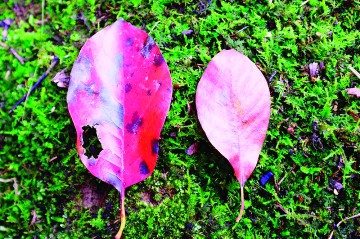

The elliptical leaves of the blackgum tree typically turn scarlet red to orange. Blackgums have the added attraction of blue berries (not blueberries) that birds feed on during stops on their migration. These leaves are noted for their glossy shine and dark color. In similar habitat, you may also come across the starfish-like leaves of the sweetgum tree, which usually has five, but up to seven, pointed lobes. The entire autumn color spectrum could appear here, as sweetgum leaves may be yellow, red, purple or orange.
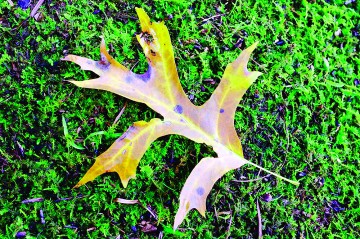
Oak and maple are the trees most synonymous with fall in Chesapeake Country, with numerous species of both. Scarlet oak, a very common find, is known for the C-shaped sinuses between the lobes of its leaf. Before you think of sneezing on this very paper, in botany a sinus is defined as the space between two lobes or teeth (on a leaf). While the leaves of some scarlet oaks may become deep red as the name suggests, many times the leaves are brown. White oak, on the other hand, has more rounded, uniform lobes and can be of many different autumn colors.
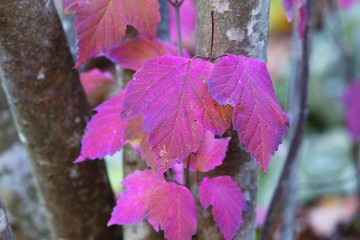
Red maple, one of the most common maple trees in the region, appears almost aflame in its brilliant namesake-colored foliage. The leaves of the red maple feature three to five lobes with narrow sinuses. Many have only three; for those with five, the three at the end of the leaf are always larger than the two at the base.
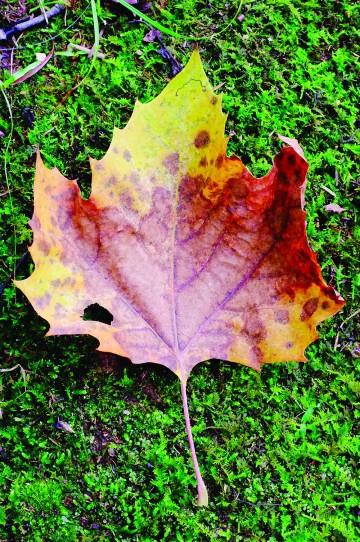
Some of the odder-looking leaves you may encounter will come from both the tulip poplar and sassafras trees. Tulip poplar (also known as yellow poplar) in autumn will have bright yellow leaves that are almost shaped like a bowl and resemble a tulip. Sassafras can provide brilliant shades of red, yellow and orange to the landscape. Its leaves may have three lobes (resembling a dinosaur footprint), two lobes (resembling mittens) or no lobes — all attached to the same branch.
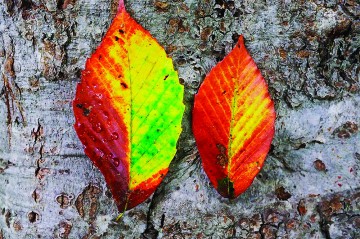
Some other species to be on the lookout for include hornbeam, black walnut and beech. All three of these trees produce gorgeous shades of yellow, though hornbeam may be red as well. Beech is unique in that its leaves will remain on the tree through the winter.
Finally, search for the oval leaves of the persimmon tree, which can range from yellow to red. During autumn, the tree is also fruiting small edible orange berries that resemble a tomato, which is especially beautiful paired with the leaves.

I hope you’re inspired to get outside and search for autumn leaves. You need not be an expert to have fun and enjoy the beauty of autumn. If you want to learn more, get that guidebook and study botany.
